Air Pollution Characteristics and Health Risks in the Yangtze River Economic Belt, China during Winter
Abstract
:1. Introduction
2. Data and Methodology
2.1. Study Region
2.2. Date Source
2.3. Methods
2.3.1. AQI
2.3.2. AAQI
2.3.3. HAQI
3. Results and Discussion
3.1. Wintertime Air Quality Overview
3.2. Spatial Variability
3.3. Major Pollutant
3.4. Health Risks Assessment
4. Conclusions
Supplementary Materials
Author Contributions
Funding
Acknowledgments
Conflicts of Interest
References
- Cao, J.; Xu, H.; Xu, Q.; Chen, B.; Kan, H. Fine particulate matter constituents and cardiopulmonary mortality in a heavily polluted Chinese city. Environ. Health Perspect. 2012, 120, 373–378. [Google Scholar] [CrossRef] [PubMed] [Green Version]
- Shang, Y.; Sun, Z.; Cao, J.; Wang, X.; Zhong, L.; Bi, X.; Li, H.; Liu, W.; Zhu, T.; Huang, W. Systematic review of Chinese studies of short-term exposure to air pollution and daily mortality. Environ. Int. 2013, 54, 100–111. [Google Scholar] [CrossRef]
- Fang, D.; Chen, B.; Hubacek, K.; Ni, R.; Chen, L.; Feng, K.; Lin, J. Clean air for some: Unintended spillover effets of regional air pollution policies. Sci. Adv. 2019, 5, eaav4707. [Google Scholar] [CrossRef] [Green Version]
- Zhang, X.; Mao, M.; Yin, Y.; Tang, S. The absorption Ångstrom exponent of black carbon with brown coatings: Effects of aerosol microphysics and parameterization. Atmos. Chem. Phys. 2020, 20, 9701–9711. [Google Scholar] [CrossRef]
- Li, R.; Wang, Z.; Cui, L.; Fu, H.; Zhang, L.; Kong, L.; Chen, W.; Chen, J. Aair pollution characteristics in China during 2015–2016: Spationtemporal variations and key meteorological factors. Sci. Total Environ. 2019, 648, 902–915. [Google Scholar] [CrossRef]
- Guo, H.; Gu, X.; Ma, G.; Shi, S.; Wang, W.; Zuo, X.; Zhang, X. Spatial and temporal variation of air quality and six air pollutants in China during 2015–2017. Sci. Rep. 2019, 9, 15201. [Google Scholar] [CrossRef] [Green Version]
- Ma, X.; Jia, H.; Sha, T.; An, J.; Tian, R. Spatial and seasonal characteristics of particulate matter and gaseous pollution in China: Implications for control policy. Environ. Pollut. 2019, 248, 421–428. [Google Scholar] [CrossRef] [PubMed]
- Zeng, Y.; Cao, Y.; Qiao, X.; Seyler, B.; Tang, Y. Air pollution reduciton in China: Recent success but great challenge for the future. Sci. Total Environ. 2019, 663, 329–337. [Google Scholar] [CrossRef] [PubMed]
- Yu, F.; Wang, Q.; Yan, Q.; Jiang, N.; Wei, J.; Wei, Z.; Yin, S. Particle size distribution, cemical composition and meteorological factor analysis: A case study during wintertime snow cover in Zhengzhou, China. Atmos. Res. 2018, 202, 140–147. [Google Scholar] [CrossRef]
- Lelieveld, J.; Evans, J.S.; Fnais, M.; Giannadaki, D.; Pozzer, A. The contribution of outdoor air pollution sources to premature mortality on a global scale. Nature 2015, 525, 367–371. [Google Scholar] [CrossRef]
- Li, C.; Dai, Z.; Yang, L.; Ma, Z. Spatiotemporal Characteristics of Air Quality across Weifang from 2014–2018. Int. J. Environ. Res. Public Health 2019, 16, 3122. [Google Scholar] [CrossRef] [PubMed] [Green Version]
- Maji, K.J.; Ye, W.F.; Arora, M.; Nagendra, S.M.S. PM2.5-related health and economic loss assessment for 338 Chinese cities. Environ. Inter. 2018, 121, 392–403. [Google Scholar] [CrossRef] [PubMed]
- Feng, Y.; Cheng, J.; Shen, J.; Sun, H. Spatial effects of air pollution on public health in China. Environ. Resour. Econ. 2019, 73, 229–250. [Google Scholar] [CrossRef]
- Gu, H.; Cao, Y.; Elahi, E.; Jha, S.K. Human health damages related to air polluton in China. Environ. Sci. Pollut. Res. 2019, 26, 13115–13125. [Google Scholar] [CrossRef]
- The Outline of Yangtze River Economic Belt Development ProgramPlan. Available online: http://www.gov.cn/xinwen/2016-09/12/content_5107501.htm (accessed on 30 January 2019).
- Wang, S.; Zhou, C.; Wang, Z.; Feng, K.; Hubacek, K. The characteristics and drivers of fine particulate matter (PM2.5) distribution in China. J. Clean. Prod. 2017, 142, 1800–1809. [Google Scholar] [CrossRef]
- Zhao, S.; Yu, Y.; Yin, D.; Qin, D.; He, J.; Dong, L. Spatial patterns and temporal varations of six criteria air pollutants during 2015 to 2017 in the city clusters of Sichuan Basin, China. Sci. Total Environ. 2018, 624, 540–557. [Google Scholar] [CrossRef]
- Li, L.; An, J.Y.; Shi, Y.Y.; Zhou, M.; Yan, R.S.; Huang, C.; Wang, H.L.; Lou, S.R.; Wang, Q.; Lu, Q.; et al. Source apporotionment of surface ozone in the Yangtze River Delta, China in summer of 2013. Atmos. Environ. 2016, 144, 194–207. [Google Scholar] [CrossRef]
- Chen, T.; He, J.; Lu, X.; She, J.; Guan, Z. Spatial and temporal variations of PM2.5 and its relation to metorological factor in urban area of Nanjing, China. Int. J. Environ. Res. Public Health 2016, 13, 921. [Google Scholar] [CrossRef]
- Nie, D.; Chen, M.; Wu, Y.; Ge, X.; Hu, J.; Zhang, K.; Ge, P. Characterization of fine particulate matter and associated health burden in Nanjing. Int. J. Environ. Res. Public Health 2018, 15, 602. [Google Scholar] [CrossRef] [Green Version]
- Zhao, Q.; Huo, J.; Yang, X.; Fu, Q.; Duan, Y.; Liu, Y.; Lin, Y.; Zhang, Q. Chemical characterization and source identification of submicron aerosols from a year-long real-time observation at a rural site of Shanghai using an Aerosol Chemical Speciation Monitor. Atmos. Res. 2020, 246, 105154. [Google Scholar] [CrossRef]
- Mao, M.; Zhang, X.; Yin, Y. Particulate matter and gaseous pollutions in three metropolises along the Chinese Yangtze River: Situation and Implications. Int. J. Environ. Res. Public Health 2018, 15, 1102. [Google Scholar] [CrossRef] [PubMed] [Green Version]
- Kyrkilis, G.; Chaloulakou, A.; Kassomenos, P.A. Development of an aggregate air quality index for an urban mediterranean agglomeration: Relation to potential health effects. Environ. Int. 2007, 33, 670–676. [Google Scholar] [CrossRef] [PubMed]
- Wong, T.W.; San Tam, W.W.; Yu, I.T.S.; Lau, A.K.H.; Pang, S.W.; Wong, A.H. Developing a risk-based air quality health index. Atmos. Environ. 2013, 76, 52–58. [Google Scholar] [CrossRef]
- Hu, J.; Ying, Q.; Wang, Y.; Zhang, H. Characterizing multi-pollutant air pollution in China: Comparison of three air quality indices. Environ. Int. 2015, 84, 17–25. [Google Scholar] [CrossRef] [PubMed]
- Shen, F.; Ge, X.; Hu, J.; Nie, D.; Tian, L.; Chen, M. Air pollution characteristics and health risks in Henan Province, China. Environ. Res. 2017, 156, 625–634. [Google Scholar] [CrossRef]
- Luo, H.; Guan, Q.; Lin, J.; Wang, Q.; Yang, L.; Tan, Z.; Wang, N. Air pollution characteristics and human health risks in key cities of northwest China. J. Environ. Manag. 2020, 269, 110791. [Google Scholar] [CrossRef]
- Shen, F.; Zhang, L.; Jiang, L.; Tang, M.; Gai, X.; Chen, M.; Ge, X. Temporal variations of six ambient criteria air pollutants from 2015 to 2018, their spatial distributions, health risks and relationships with socioeconomic factors during 2018 in China. Environ. Int. 2020, 137, 105556. [Google Scholar] [CrossRef]
- The China National Environmental Monitoring Centre. Available online: http://www.cnemc.cn (accessed on 7 December 2020).
- The Chinese Statistics Web Links. Available online: http://www.tjcn.org/tjgb (accessed on 7 December 2020).
- Ministry of Environmental Protection (MEP). Ambient Air Quality Standards; GB3095-2012; MEP: Beijing, China, 2012; pp. 1–6. [Google Scholar]
- Ministry of Environmental Protection (MEP). Technical Regulation on Ambient Air Quality Index (On Trial); HJ633-2012; MEP of the People’s Republic of China or Chinese Ministry of Environmental Protection, Governmental Documents: Beijing, China, 2012. [Google Scholar]
- Swamee, P.K.; Tyagi, A. Formation of an air pollution index. J. Air Waste Manag. Assoc. 1999, 49, 88–91. [Google Scholar] [CrossRef]
- Cairncross, E.K.; John, J.; Zunckel, M. A novel air pollution index based on the relative risk of daily mortality associated with short-term exposure to common air pollutants. Atmos. Environ. 2007, 41, 8442–8454. [Google Scholar] [CrossRef]
- He, J.; Gong, S.; Yu, Y.; Yu, L.; Wu, L.; Mao, H.; Song, C.; Zhao, S.; Liu, H.; Li, X.; et al. Air pollution characteristics and their relation to meteorological conditions during 2014–2015 in major Chinese cities. Environ. Pollut. 2017, 223, 484–496. [Google Scholar] [CrossRef]
- Mao, M.; Zhang, X.; Shao, Y.; Yin, Y. Spatiotemporal Variations and Factors of Air Quality in Urban Central China during 2013–2015. Int. J. Environ. Res. Public Health 2020, 17, 229. [Google Scholar] [CrossRef] [PubMed] [Green Version]
- Kuerban, M.; Waili, Y.; Fan, F.; Liu, Y.; Qin, W.; Dore, A.J.; Peng, J.; Xu, W.; Zhang, F. Spatio-temporal patterns of air pollution in China from 2015 to 2018 and implications for health risks. Environ. Pollut. 2020, 258, 113659. [Google Scholar] [CrossRef]
- Li, C.; Liu, M.; Hu, Y.; Zhou, R.; Huang, N.; Wu, W.; Liu, C. Spatial distribution characteristics of gaseous pollutants and particulate matter inside a city in the heating season of Northeast China. Sustain. Cities Soc. 2020, 61, 102302. [Google Scholar] [CrossRef]
- Zhao, S.; Yin, D.; Yu, Y.; Kang, S.; Qin, D.; Dong, L. PM2.5 and O3 pollution during 2015-2019 over 367 Chinese cities: Spatiotemporal variations, meteorological and topographical impacts. Environ. Pollut. 2020, 264, 114694. [Google Scholar] [CrossRef] [PubMed]
- Sheppard, L.; Levy, D.; Checkoway, H. Correcting for the effects of location and atmospheric conditions on air pollution exposures in a case-crossover study. J. Expos. Anal. Environ. Epidemiol. 2001, 11, 86–96. [Google Scholar] [CrossRef] [Green Version]
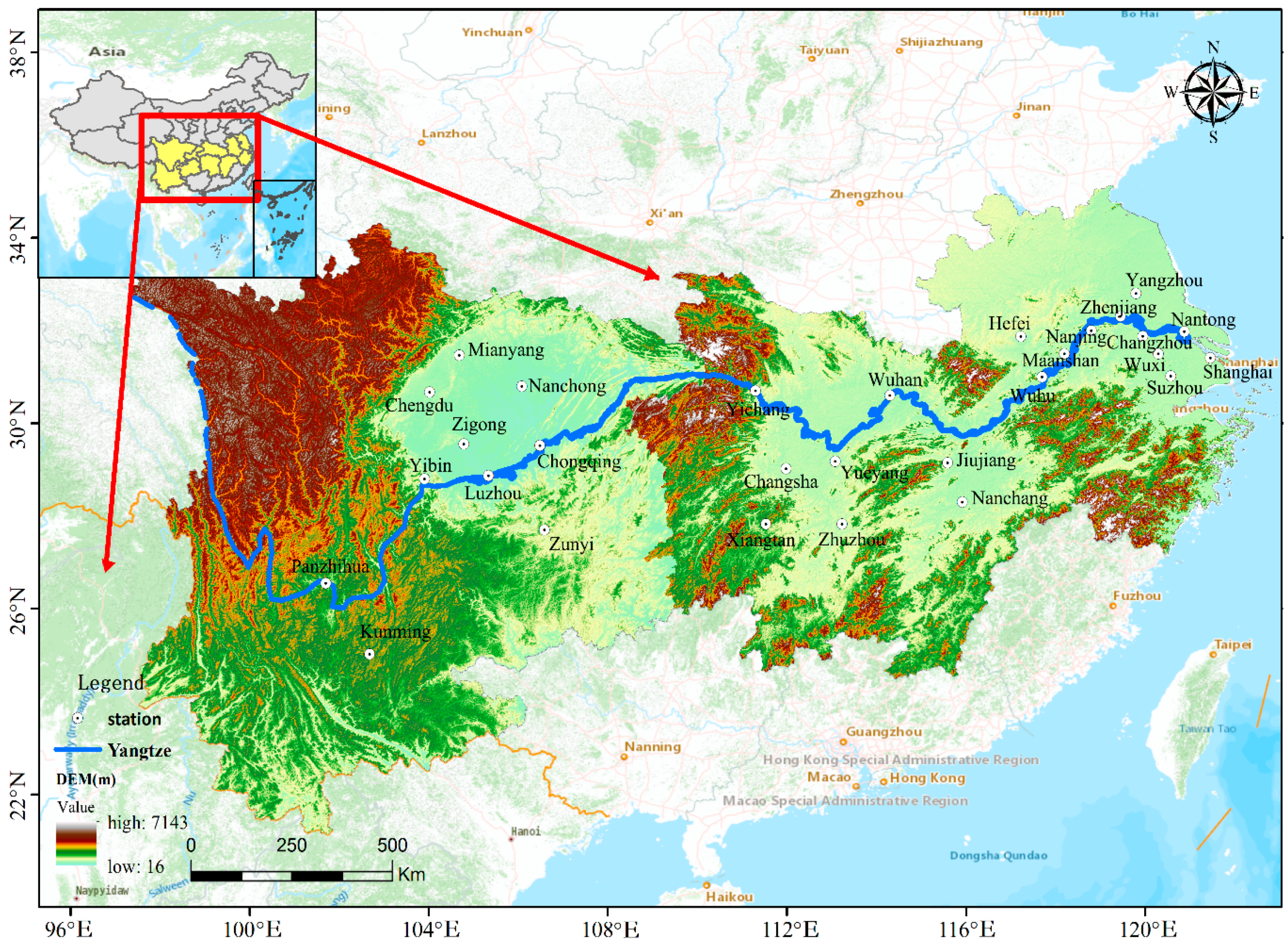
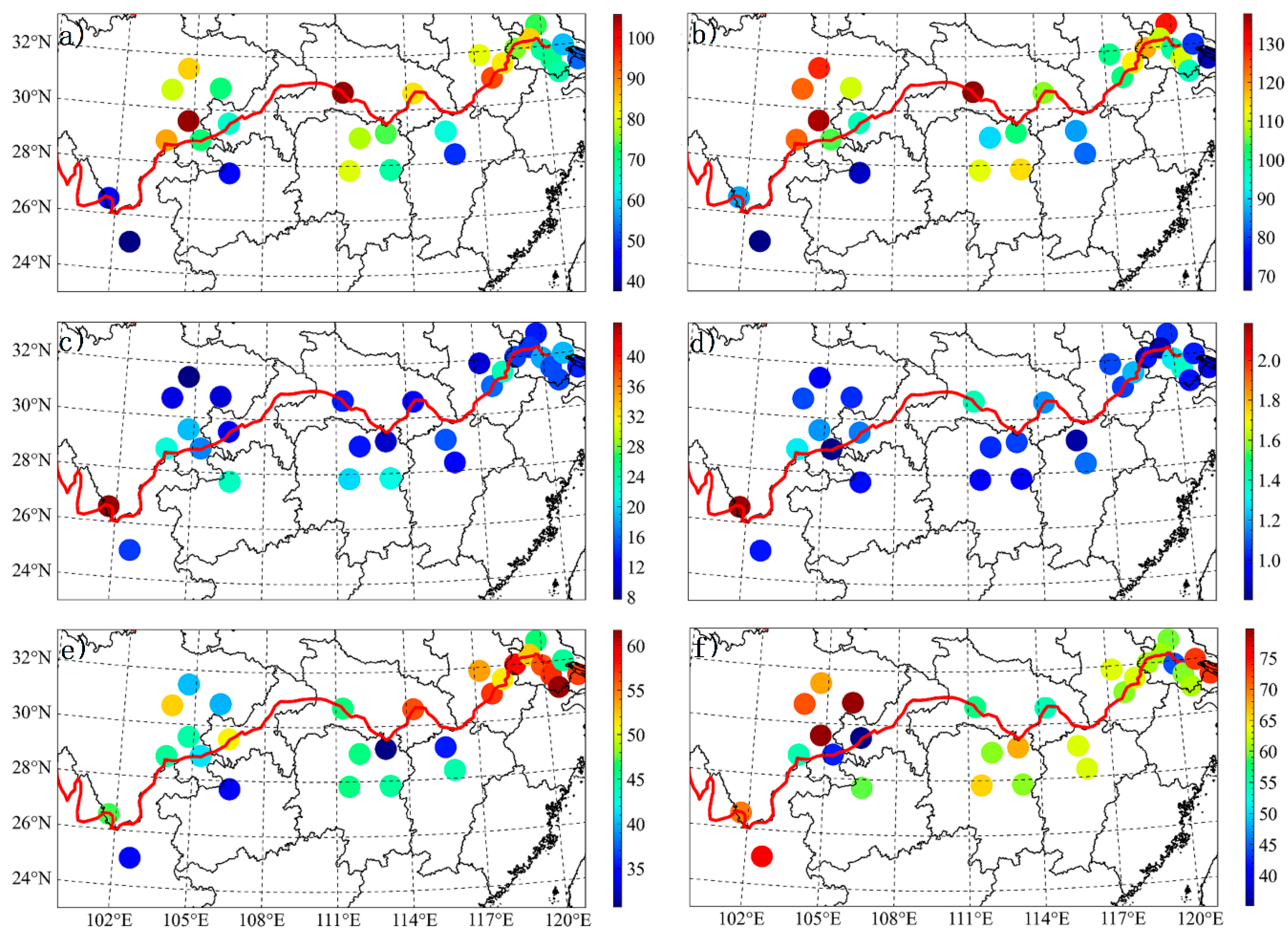


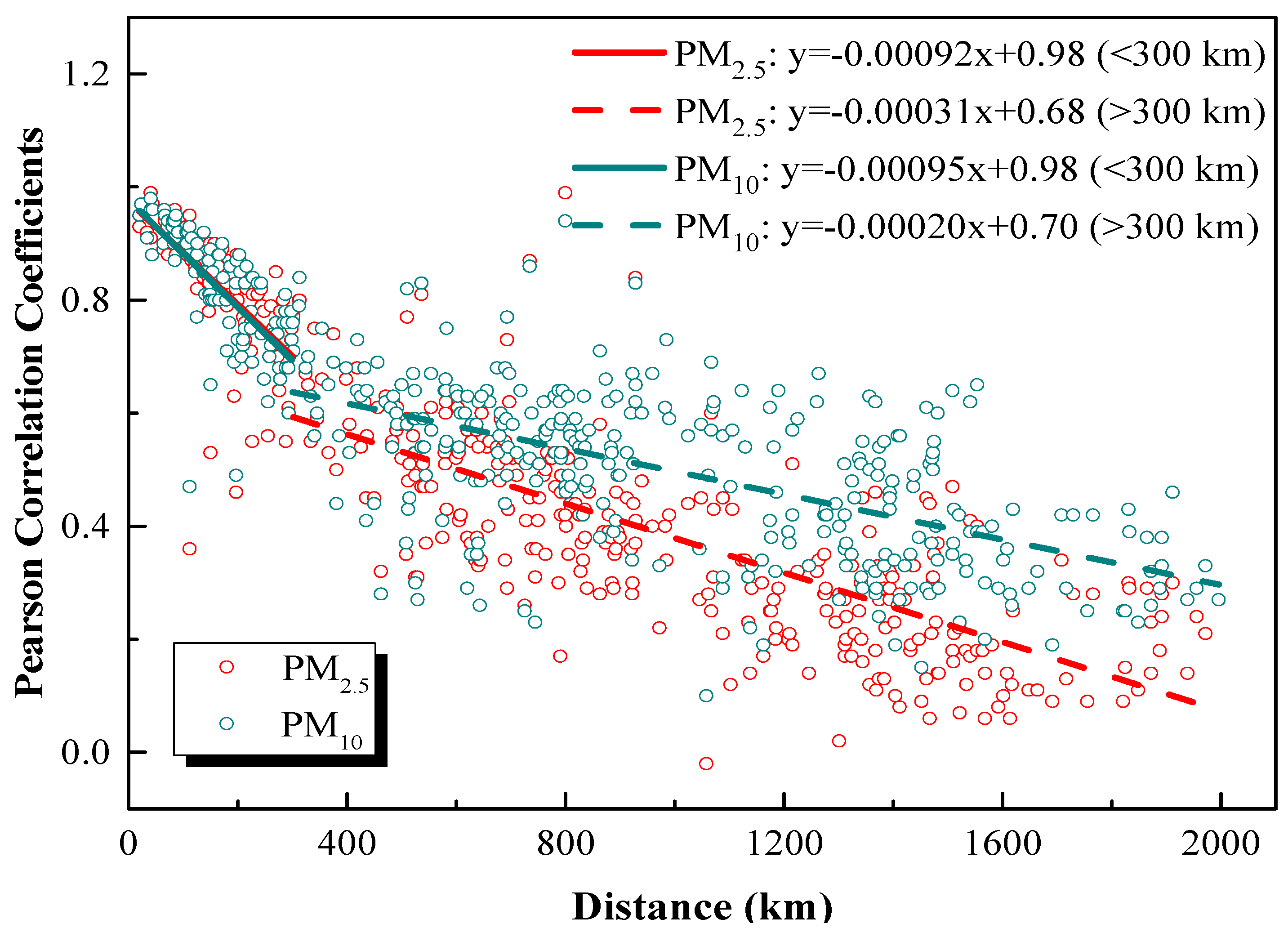
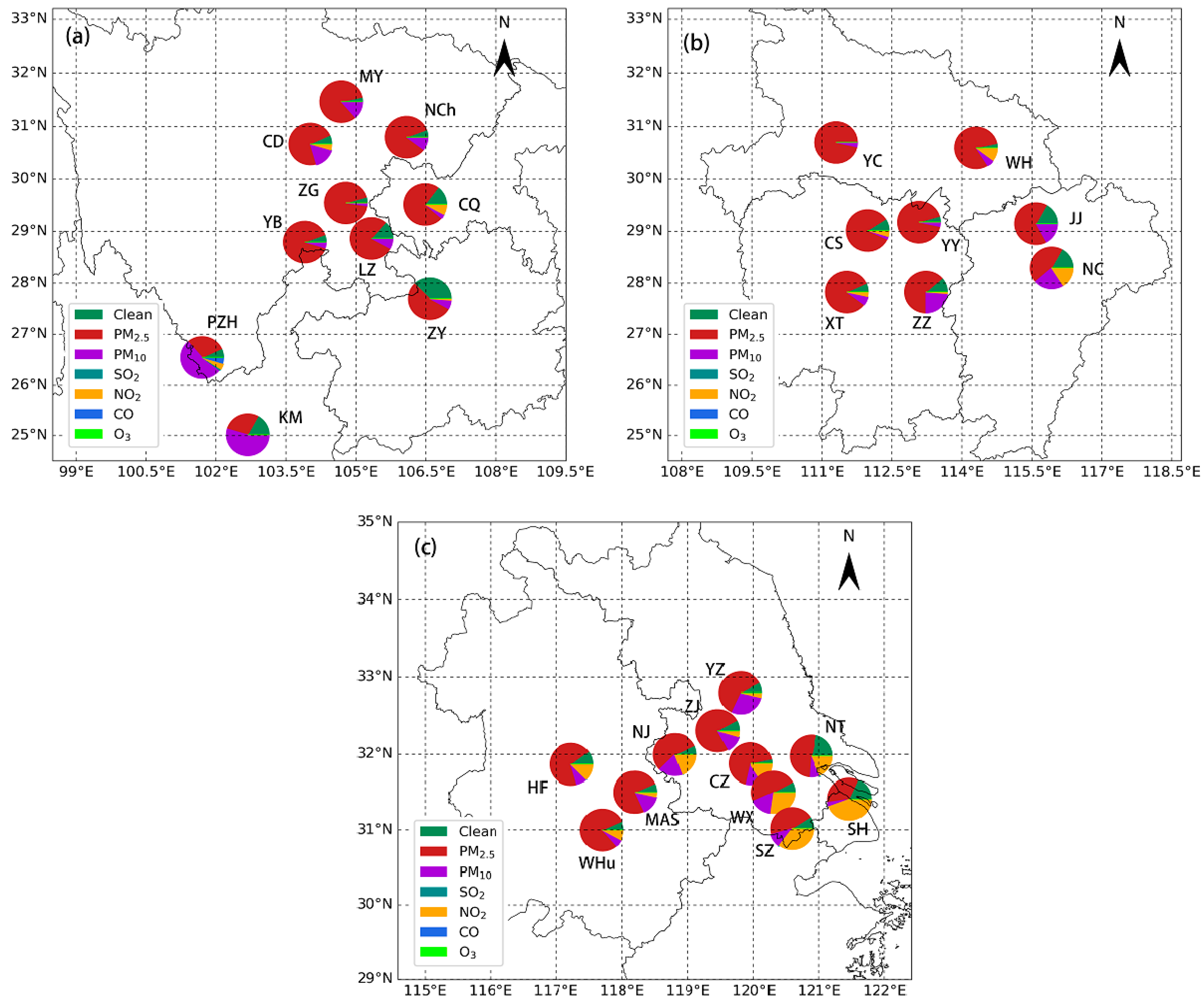




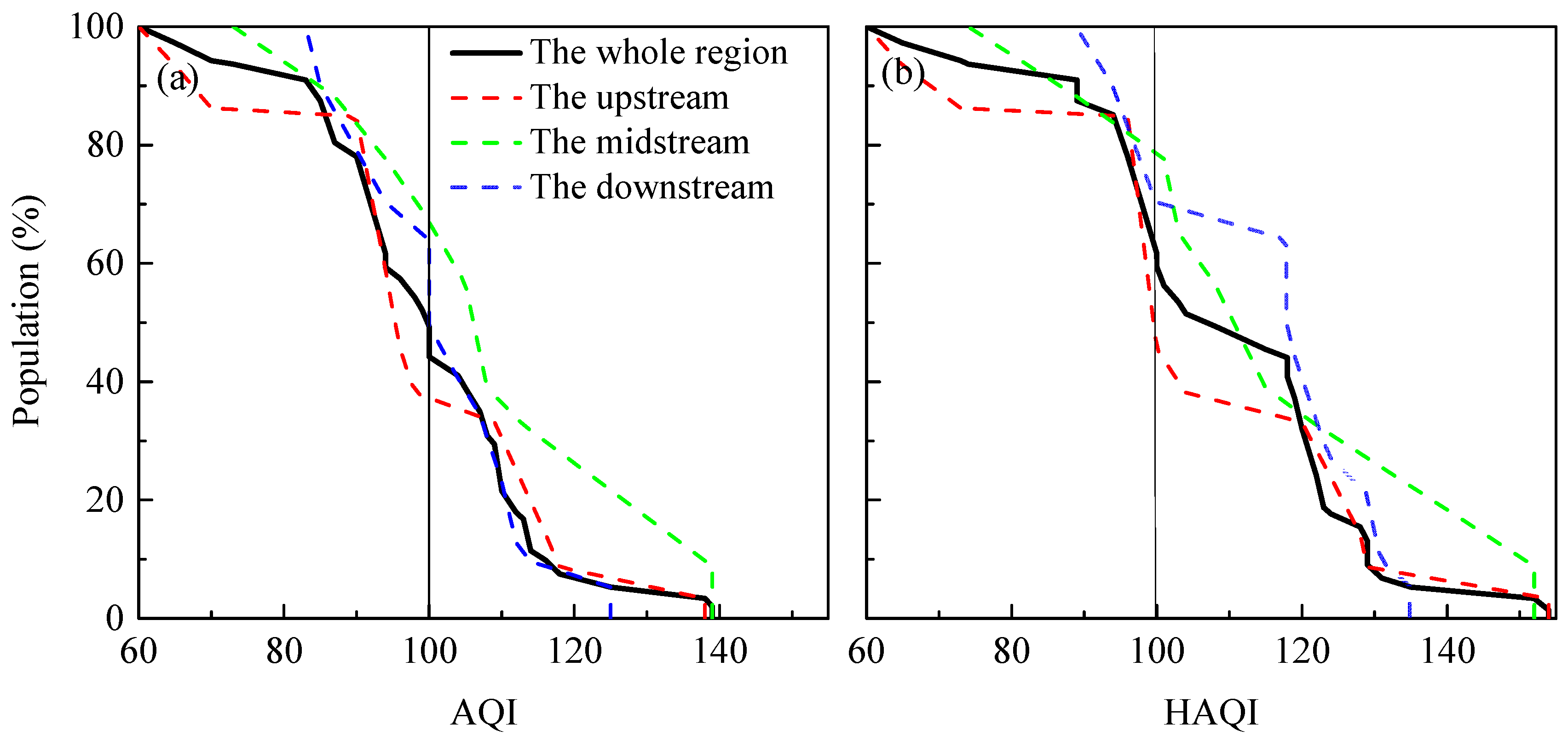
| Cities | Latitude (Degree) | Longitude (Degree) | Area (Km2) | Population (Million) | GDP (Billion) | Vehicle (Ten Thousand) | Number of Monitoring Sites |
|---|---|---|---|---|---|---|---|
| The upstream | |||||||
| Panzhihua (PZH) | 26.6 | 101.7 | 7401 | 1.2 | 114.4 | 26.0 | 5 |
| Kunming (KM) | 25.0 | 102.7 | 21,281 | 5.7 | 485.8 | 213.5 | 7 |
| Chengdu (CD) | 30.7 | 104.0 | 14,335 | 16.3 | 1388.9 | 398.2 | 10 |
| Yibin (YB) | 28.8 | 104.6 | 13,271 | 4.6 | 184.7 | 32.3 | 6 |
| Mianyang (MY) | 31.5 | 104.7 | 20,248 | 4.9 | 207.5 | 17.5 | 4 |
| Zigong (ZG) | 29.4 | 104.8 | 4381 | 2.9 | 131.2 | 22.4 | 6 |
| Luzhou (LZ) | 28.9 | 105.4 | 12,232 | 4.3 | 159.6 | 37.8 | 4 |
| Nanchong (NCh) | 30.8 | 106.1 | 12,477 | 6.4 | 182.8 | 46.2 | 6 |
| Chongqing (CQ) | 29.5 | 106.5 | 82,400 | 34.0 | 1950.0 | 320.7 | 21 |
| Zunyi (ZY) | 27.7 | 106.9 | 30,762 | 6.2 | 272.7 | 70.1 | 5 |
| The midstream | |||||||
| Yichang (YC) | 30.7 | 111.3 | 21,230 | 4.1 | 385.7 | 56.7 | 5 |
| Xiangtan (XT) | 27.8 | 112.9 | 5006 | 2.9 | 205.6 | 61.1 | 7 |
| Changsha (CS) | 28.1 | 113.0 | 11,816 | 8.2 | 1053.5 | 256.5 | 10 |
| Yueyang (YY) | 29.4 | 113.1 | 14,858 | 5.8 | 325.8 | 49.0 | 6 |
| Zhuzhou (ZZ) | 27.8 | 113.1 | 11,248 | 4.0 | 252.2 | 44.0 | 7 |
| Wuhan (WH) | 30.6 | 114.3 | 8569 | 11.1 | 1341.0 | 261.0 | 10 |
| Jiujiang (JJ) | 29.5 | 115.6 | 19,085 | 4.9 | 241.4 | 65.9 | 8 |
| Nanchang (NC) | 28.6 | 115.9 | 7402 | 5.5 | 500.3 | 97.0 | 10 |
| The downstream | |||||||
| Hefei (HF) | 31.8 | 117.2 | 11,445 | 7.6 | 721.4 | 169.7 | 10 |
| Wuhu (WHu) | 31.3 | 118.4 | 6026 | 3.9 | 306.6 | 47.7 | 4 |
| Maanshan (MAS) | 31.7 | 118.5 | 4049 | 2.3 | 173.8 | 31.1 | 5 |
| Nanjing (NJ) | 32.0 | 118.8 | 6587 | 8.4 | 1171.5 | 257.9 | 9 |
| Yangzhou (YZ) | 32.4 | 119.4 | 6591 | 4.5 | 506.5 | 94.0 | 5 |
| Zhenjiang (ZJ) | 32.2 | 119.5 | 3840 | 3.2 | 410.5 | 49.6 | 5 |
| Changzhou (CZ) | 31.8 | 120.0 | 4374 | 4.7 | 662.2 | 122.8 | 9 |
| Wuxi (WX) | 31.6 | 120.3 | 4627 | 6.6 | 1051.2 | 176.5 | 8 |
| Suzhou (SZ) | 31.3 | 120.6 | 8657 | 10.7 | 1730.0 | 355.7 | 8 |
| Nantong (NT) | 32.0 | 120.9 | 10,549 | 7.3 | 773.5 | 187.3 | 5 |
| Shanghai (SH) | 31.4 | 121.5 | 6341 | 14.6 | 3013.4 | 361.0 | 10 |
| Cities | PM2.5 (μg/m3) | PM10 (μg/m3) | SO2 (μg/m3) | CO (mg/m3) | NO2 (μg/m3) | O3 8 h (μg/m3) |
|---|---|---|---|---|---|---|
| PZH | 45.7 ± 14.7 | 86.7 ± 27.1 | 44.4 ± 16.6 | 2.2 ± 0.7 | 47.2 ± 12.1 | 70.0 ± 21.6 |
| KM | 37.6 ± 15.8 | 66.2 ± 22.0 | 14.5 ± 4.1 | 1.0 ± 0.2 | 34.4 ± 7.8 | 76.3 ± 27.4 |
| CD | 79.5 ± 36.1 | 123.6 ± 55.8 | 10.9 ± 3.5 | 1.1 ± 0.3 | 52.1 ± 16.6 | 71.7 ± 23.6 |
| YB | 87.8 ± 40.2 | 123.7 ± 56.0 | 21. 9± 5.9 | 1.3 ± 0.3 | 45.1 ± 11.2 | 54.6 ± 29.8 |
| MY | 84.6 ± 41.4 | 128.0 ± 69.4 | 7.8 ± 3.2 | 1.0 ± 0.3 | 40.3 ± 14.9 | 68.0 ± 23.5 |
| ZG | 105.4 ± 45.3 | 136.4 ± 58.2 | 19.2 ± 6.7 | 1.2 ± 0.3 | 44.4 ± 16.4 | 79.7 ± 35.1 |
| LZ | 71.4 ± 37.3 | 104.7 ± 52.9 | 17.0 ± 7.2 | 0.8 ± 0.3 | 41.5 ± 13.8 | 42.3 ± 27.6 |
| NCh | 71.3 ± 28.2 | 110.5 ± 43.5 | 10.4 ± 3.6 | 1.0 ± 0.2 | 39.9 ± 14.4 | 79.7 ± 24.6 |
| CQ | 65.3 ± 35.1 | 96.5 ± 49.8 | 11.1 ± 3.5 | 1.1 ± 0.2 | 50.9 ± 14.2 | 35.2 ± 20.3 |
| ZY | 45.9 ± 24.8 | 69.9 ± 36.2 | 23.0 ± 11.9 | 1.0 ± 0.2 | 33.6 ± 12.6 | 59.4 ± 23.3 |
| YC | 105. 7± 39.0 | 137.7 ± 49.4 | 13.5 ± 2.4 | 1.4 ± 0.2 | 45.9 ± 13.6 | 56.8 ± 23.6 |
| XT | 80.6 ± 38.8 | 111.6 ± 48.5 | 20.1 ± 12.9 | 1.0 ± 0.2 | 45.8 ± 18.3 | 65.7 ± 29.2 |
| CS | 78.3 ± 37.8 | 92.2 ± 43.8 | 13.2 ± 8.6 | 1.0 ± 0.2 | 45.8 ± 18.6 | 60.5 ± 28.2 |
| YY | 74.3 ± 26.0 | 101.8 ± 34.1 | 9.9 ± 4.7 | 1.1 ± 0.2 | 30.7 ± 12.5 | 67.5 ± 26.7 |
| ZZ | 68.4 ± 33.4 | 114.5 ± 51.4 | 21.4 ± 10.5 | 0.9 ± 0.2 | 44.9 ± 16.0 | 60.5 ± 29.6 |
| WH | 83.3 ± 35.1 | 106.7 ± 42.3 | 12.2 ± 7.0 | 1.2 ± 0.3 | 56.4 ± 22.0 | 54.4 ± 25.2 |
| JJ | 63.9 ± 30.9 | 86.1 ± 40.4 | 15.5 ± 7.1 | 0.8 ± 0.2 | 35.4 ± 13.2 | 63.3 ± 20.5 |
| NC | 49.5 ± 22.7 | 82.5 ± 36.7 | 12.6 ± 7.1 | 1.1 ± 0.3 | 44.3 ± 15.9 | 63.1 ± 26.7 |
| HF | 81.1 ± 43.0 | 100.5 ± 45.4 | 10.2 ± 5.8 | 1.1 ± 0.3 | 53.6 ± 22.2 | 63.3 ± 22.5 |
| WHu | 94.1 ± 54.1 | 105.1 ± 52.3 | 16.1 ± 6.8 | 1.1 ± 0.4 | 57.0 ± 20.4 | 60.5 ± 26.3 |
| MAS | 82.6 ± 48.3 | 113.0 ± 54.6 | 23.4 ± 9.3 | 1.2 ± 0.4 | 51.3 ± 20.1 | 63.1 ± 21.4 |
| NJ | 75.7 ± 51.1 | 118.3 ± 64.7 | 14.7 ± 5.3 | 1.0 ± 0.4 | 58.4 ± 23.2 | 61.3 ± 21.1 |
| YZ | 73.7 ± 41.1 | 129.1 ± 66.1 | 13.4 ± 7.0 | 1.0 ± 0.4 | 46.3 ± 23.4 | 59.9 ± 19.7 |
| ZJ | 84.5 ± 53.3 | 110.0 ± 59.8 | 14.3 ± 8.1 | 0.8 ± 0.4 | 52.3 ± 25.5 | 60.9 ± 20.1 |
| CZ | 68.6 ± 34.8 | 98.7 ± 40.9 | 18.4 ± 4.5 | 1.3 ± 0.3 | 56.2 ± 15.8 | 44.4 ± 13.5 |
| WX | 69.9 ± 46.9 | 111.0 ± 62.1 | 15.2 ± 6.1 | 1.4 ± 0.4 | 57.3 ± 22.2 | 60.2 ± 21.7 |
| SZ | 67.9 ± 46.2 | 96.5 ± 53.1 | 15.0 ± 6.6 | 1.0 ± 0.4 | 61.7 ± 24.7 | 61.6 ± 21.0 |
| NT | 58.8 ± 38.3 | 78.9 ± 45.4 | 19.0 ± 6.9 | 1.0 ± 0.3 | 45.0 ± 21.5 | 73.0 ± 17.7 |
| SH | 52.9 ± 36.7 | 69.2 ± 38.3 | 13.7 ± 5.1 | 0.9 ± 0.3 | 56.8 ± 21.9 | 73.1 ± 19.3 |
| CAAQS-I/II | 35/75 | 50/150 | 50/150 | 2/4 | 40/80 | 100/160 |
| PZH | KM | CD | YB | MY | ZG | LZ | NCh | CQ | ZY | YC | XT | CS | YY | ZZ | WH | JJ | NC | HF | WHu | MAS | NJ | YZ | ZJ | CZ | WX | SZ | NT | SH | |
|---|---|---|---|---|---|---|---|---|---|---|---|---|---|---|---|---|---|---|---|---|---|---|---|---|---|---|---|---|---|
| PZH | — | 0.46 | 0.48 | 0.50 | 0.38 | 0.45 | 0.45 | 0.38 | 0.38 | 0.31 | 0.27 | 0.24 | 0.23 | 0.17 | 0.29 | 0.17 | 0.23 | 0.27 | 0.25 | 0.34 | 0.28 | 0.28 | 0.29 | 0.30 | 0.29 | 0.28 | 0.30 | 0.24 | 0.27 |
| KM | 0.49 | — | 0.34 | 0.32 | 0.31 | 0.31 | 0.35 | 0.26 | 0.37 | 0.51 | 0.00 | 0.23 | 0.21 | 0.14 | 0.29 | 0.02 | 0.11 | 0.13 | 0.06 | 0.09 | 0.13 | 0.09 | 0.15 | 0.09 | 0.11 | 0.14 | 0.18 | 0.14 | 0.21 |
| CD | 0.43 | 0.26 | — | 0.82 | 0.92 | 0.86 | 0.82 | 0.88 | 0.85 | 0.62 | 0.62 | 0.40 | 0.36 | 0.30 | 0.48 | 0.34 | 0.34 | 0.41 | 0.34 | 0.33 | 0.29 | 0.28 | 0.37 | 0.35 | 0.22 | 0.18 | 0.19 | 0.14 | 0.11 |
| YB | 0.44 | 0.28 | 0.86 | — | 0.73 | 0.89 | 0.94 | 0.75 | 0.80 | 0.56 | 0.59 | 0.41 | 0.37 | 0.32 | 0.46 | 0.40 | 0.43 | 0.43 | 0.32 | 0.33 | 0.27 | 0.26 | 0.30 | 0.31 | 0.21 | 0.17 | 0.18 | 0.10 | 0.11 |
| MY | 0.29 | 0.23 | 0.92 | 0.78 | — | 0.81 | 0.75 | 0.84 | 0.78 | 0.63 | 0.57 | 0.37 | 0.35 | 0.29 | 0.45 | 0.30 | 0.31 | 0.34 | 0.29 | 0.28 | 0.27 | 0.25 | 0.32 | 0.31 | 0.20 | 0.14 | 0.16 | 0.12 | 0.08 |
| ZG | 0.41 | 0.30 | 0.88 | 0.91 | 0.83 | — | 0.90 | 0.85 | 0.82 | 0.64 | 0.60 | 0.47 | 0.44 | 0.35 | 0.54 | 0.41 | 0.45 | 0.45 | 0.32 | 0.33 | 0.30 | 0.28 | 0.33 | 0.33 | 0.23 | 0.18 | 0.18 | 0.14 | 0.12 |
| LZ | 0.44 | 0.37 | 0.83 | 0.91 | 0.73 | 0.90 | — | 0.76 | 0.88 | 0.63 | 0.61 | 0.45 | 0.41 | 0.36 | 0.50 | 0.39 | 0.42 | 0.44 | 0.27 | 0.29 | 0.23 | 0.21 | 0.29 | 0.27 | 0.18 | 0.13 | 0.14 | 0.07 | 0.06 |
| NCh | 0.35 | 0.25 | 0.87 | 0.74 | 0.80 | 0.85 | 0.78 | — | 0.83 | 0.66 | 0.58 | 0.39 | 0.36 | 0.29 | 0.49 | 0.30 | 0.37 | 0.40 | 0.25 | 0.25 | 0.22 | 0.19 | 0.28 | 0.25 | 0.17 | 0.12 | 0.13 | 0.08 | 0.06 |
| CQ | 0.41 | 0.35 | 0.76 | 0.73 | 0.66 | 0.80 | 0.88 | 0.81 | — | 0.68 | 0.55 | 0.45 | 0.40 | 0.33 | 0.51 | 0.35 | 0.38 | 0.44 | 0.28 | 0.30 | 0.25 | 0.21 | 0.35 | 0.28 | 0.20 | 0.16 | 0.18 | 0.10 | 0.09 |
| ZY | 0.27 | 0.45 | 0.68 | 0.62 | 0.62 | 0.68 | 0.69 | 0.75 | 0.70 | — | 0.37 | 0.46 | 0.42 | 0.34 | 0.60 | 0.17 | 0.37 | 0.46 | 0.12 | 0.20 | 0.20 | 0.14 | 0.24 | 0.19 | 0.20 | 0.18 | 0.22 | 0.19 | 0.21 |
| YC | 0.36 | 0.10 | 0.67 | 0.60 | 0.58 | 0.63 | 0.63 | 0.65 | 0.54 | 0.49 | — | 0.58 | 0.55 | 0.55 | 0.53 | 0.55 | 0.56 | 0.52 | 0.53 | 0.48 | 0.43 | 0.41 | 0.42 | 0.46 | 0.34 | 0.28 | 0.29 | 0.28 | 0.22 |
| XT | 0.33 | 0.32 | 0.65 | 0.62 | 0.60 | 0.64 | 0.61 | 0.63 | 0.55 | 0.62 | 0.71 | — | 0.99 | 0.87 | 0.93 | 0.75 | 0.77 | 0.81 | 0.61 | 0.54 | 0.55 | 0.53 | 0.52 | 0.53 | 0.47 | 0.42 | 0.43 | 0.39 | 0.36 |
| CS | 0.31 | 0.29 | 0.60 | 0.56 | 0.56 | 0.59 | 0.55 | 0.60 | 0.49 | 0.60 | 0.63 | 0.94 | — | 0.89 | 0.92 | 0.77 | 0.76 | 0.78 | 0.62 | 0.55 | 0.55 | 0.52 | 0.52 | 0.53 | 0.47 | 0.42 | 0.43 | 0.39 | 0.36 |
| YY | 0.19 | 0.22 | 0.53 | 0.51 | 0.48 | 0.49 | 0.48 | 0.49 | 0.37 | 0.48 | 0.69 | 0.86 | 0.81 | — | 0.84 | 0.79 | 0.79 | 0.73 | 0.62 | 0.61 | 0.60 | 0.57 | 0.52 | 0.54 | 0.49 | 0.45 | 0.45 | 0.40 | 0.38 |
| ZZ | 0.33 | 0.31 | 0.60 | 0.57 | 0.53 | 0.63 | 0.56 | 0.62 | 0.53 | 0.60 | 0.65 | 0.95 | 0.91 | 0.84 | — | 0.65 | 0.78 | 0.78 | 0.52 | 0.54 | 0.54 | 0.52 | 0.53 | 0.53 | 0.49 | 0.44 | 0.44 | 0.42 | 0.38 |
| WH | 0.42 | 0.27 | 0.73 | 0.67 | 0.67 | 0.65 | 0.62 | 0.64 | 0.57 | 0.58 | 0.68 | 0.75 | 0.71 | 0.71 | 0.70 | — | 0.83 | 0.70 | 0.80 | 0.66 | 0.64 | 0.61 | 0.53 | 0.56 | 0.47 | 0.43 | 0.41 | 0.34 | 0.34 |
| JJ | 0.34 | 0.29 | 0.64 | 0.62 | 0.61 | 0.58 | 0.59 | 0.62 | 0.54 | 0.66 | 0.64 | 0.82 | 0.76 | 0.74 | 0.76 | 0.80 | — | 0.84 | 0.80 | 0.75 | 0.74 | 0.68 | 0.57 | 0.62 | 0.61 | 0.59 | 0.59 | 0.51 | 0.53 |
| NC | 0.33 | 0.24 | 0.61 | 0.57 | 0.54 | 0.56 | 0.56 | 0.61 | 0.51 | 0.63 | 0.65 | 0.83 | 0.78 | 0.77 | 0.81 | 0.74 | 0.83 | — | 0.60 | 0.56 | 0.54 | 0.51 | 0.51 | 0.49 | 0.49 | 0.47 | 0.47 | 0.42 | 0.44 |
| HF | 0.43 | 0.28 | 0.67 | 0.62 | 0.64 | 0.59 | 0.54 | 0.57 | 0.49 | 0.47 | 0.64 | 0.71 | 0.64 | 0.63 | 0.64 | 0.84 | 0.79 | 0.69 | — | 0.85 | 0.86 | 0.81 | 0.73 | 0.76 | 0.70 | 0.68 | 0.67 | 0.59 | 0.58 |
| WHu | 0.42 | 0.19 | 0.49 | 0.50 | 0.40 | 0.48 | 0.43 | 0.41 | 0.34 | 0.32 | 0.56 | 0.64 | 0.58 | 0.67 | 0.62 | 0.68 | 0.56 | 0.56 | 0.77 | — | 0.97 | 0.94 | 0.84 | 0.90 | 0.90 | 0.87 | 0.85 | 0.78 | 0.78 |
| MAS | 0.42 | 0.29 | 0.55 | 0.54 | 0.51 | 0.51 | 0.44 | 0.46 | 0.38 | 0.39 | 0.54 | 0.68 | 0.62 | 0.66 | 0.68 | 0.73 | 0.69 | 0.63 | 0.85 | 0.88 | — | 0.97 | 0.87 | 0.93 | 0.92 | 0.89 | 0.87 | 0.81 | 0.80 |
| NJ | 0.42 | 0.25 | 0.56 | 0.56 | 0.52 | 0.51 | 0.45 | 0.42 | 0.37 | 0.33 | 0.51 | 0.65 | 0.58 | 0.63 | 0.64 | 0.69 | 0.64 | 0.57 | 0.80 | 0.87 | 0.96 | — | 0.88 | 0.96 | 0.93 | 0.89 | 0.86 | 0.82 | 0.79 |
| YZ | 0.39 | 0.25 | 0.52 | 0.50 | 0.45 | 0.47 | 0.43 | 0.42 | 0.39 | 0.37 | 0.52 | 0.63 | 0.58 | 0.59 | 0.62 | 0.64 | 0.60 | 0.59 | 0.83 | 0.85 | 0.91 | 0.94 | — | 0.95 | 0.88 | 0.82 | 0.80 | 0.78 | 0.71 |
| ZJ | 0.43 | 0.25 | 0.55 | 0.53 | 0.48 | 0.49 | 0.46 | 0.42 | 0.42 | 0.36 | 0.53 | 0.64 | 0.57 | 0.58 | 0.63 | 0.67 | 0.61 | 0.59 | 0.75 | 0.85 | 0.92 | 0.96 | 0.97 | — | 0.94 | 0.88 | 0.84 | 0.84 | 0.77 |
| CZ | 0.38 | 0.23 | 0.42 | 0.43 | 0.38 | 0.40 | 0.35 | 0.35 | 0.33 | 0.31 | 0.42 | 0.57 | 0.53 | 0.53 | 0.59 | 0.57 | 0.58 | 0.53 | 0.70 | 0.80 | 0.92 | 0.93 | 0.95 | 0.95 | — | 0.91 | 0.95 | 0.93 | 0.90 |
| WX | 0.38 | 0.26 | 0.39 | 0.39 | 0.34 | 0.35 | 0.29 | 0.33 | 0.29 | 0.32 | 0.38 | 0.54 | 0.47 | 0.52 | 0.56 | 0.55 | 0.58 | 0.54 | 0.68 | 0.76 | 0.90 | 0.89 | 0.90 | 0.90 | 0.96 | — | 0.99 | 0.93 | 0.95 |
| SZ | 0.46 | 0.29 | 0.40 | 0.39 | 0.37 | 0.34 | 0.29 | 0.33 | 0.28 | 0.35 | 0.39 | 0.54 | 0.47 | 0.51 | 0.55 | 0.54 | 0.59 | 0.54 | 0.68 | 0.72 | 0.88 | 0.86 | 0.88 | 0.87 | 0.93 | 0.98 | — | 0.94 | 0.96 |
| NT | 0.29 | 0.27 | 0.36 | 0.34 | 0.32 | 0.30 | 0.23 | 0.27 | 0.19 | 0.29 | 0.34 | 0.49 | 0.44 | 0.46 | 0.51 | 0.48 | 0.54 | 0.49 | 0.60 | 0.66 | 0.84 | 0.83 | 0.87 | 0.85 | 0.92 | 0.93 | 0.94 | — | 0.95 |
| SH | 0.27 | 0.33 | 0.32 | 0.29 | 0.29 | 0.26 | 0.20 | 0.28 | 0.15 | 0.37 | 0.33 | 0.47 | 0.41 | 0.47 | 0.49 | 0.44 | 0.54 | 0.51 | 0.53 | 0.60 | 0.76 | 0.72 | 0.75 | 0.73 | 0.81 | 0.88 | 0.91 | 0.94 | — |
Publisher’s Note: MDPI stays neutral with regard to jurisdictional claims in published maps and institutional affiliations. |
© 2020 by the authors. Licensee MDPI, Basel, Switzerland. This article is an open access article distributed under the terms and conditions of the Creative Commons Attribution (CC BY) license (http://creativecommons.org/licenses/by/4.0/).
Share and Cite
Mao, M.; Sun, H.; Zhang, X. Air Pollution Characteristics and Health Risks in the Yangtze River Economic Belt, China during Winter. Int. J. Environ. Res. Public Health 2020, 17, 9172. https://doi.org/10.3390/ijerph17249172
Mao M, Sun H, Zhang X. Air Pollution Characteristics and Health Risks in the Yangtze River Economic Belt, China during Winter. International Journal of Environmental Research and Public Health. 2020; 17(24):9172. https://doi.org/10.3390/ijerph17249172
Chicago/Turabian StyleMao, Mao, Haofei Sun, and Xiaolin Zhang. 2020. "Air Pollution Characteristics and Health Risks in the Yangtze River Economic Belt, China during Winter" International Journal of Environmental Research and Public Health 17, no. 24: 9172. https://doi.org/10.3390/ijerph17249172
APA StyleMao, M., Sun, H., & Zhang, X. (2020). Air Pollution Characteristics and Health Risks in the Yangtze River Economic Belt, China during Winter. International Journal of Environmental Research and Public Health, 17(24), 9172. https://doi.org/10.3390/ijerph17249172







